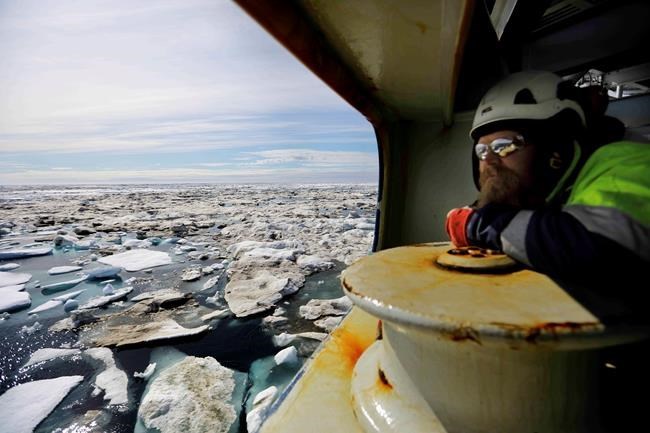
Trainee Jussi Mikkotervo looks out from the bow of the Finnish icebreaker MSV Nordica as it sails through ice floating on the Beaufort Sea off the coast of Alaska while traversing the Arctic's Northwest Passage, Sunday, July 16, 2017. Although the passage presents an attractive shortcut for maritime traffic between the Pacific and Atlantic oceans, only a dozen or two vessels attempt to navigate the poorly charted Canadian Arctic Archipelago during the brief summer window each year. (AP Photo/David Goldman)
July 19, 2017 - 4:57 PM
European explorers had long speculated about the existence of an Arctic route that connected the Atlantic and Pacific Oceans and would avoid the long journey around South America's Cape Horn.
For centuries, able seafarers failed to find the Northwest Passage, among them John Cabot, Henry Hudson, Francis Drake and James Cook.
Harsh weather, thick ice and treacherous shallows forced many expeditions to turn back. Those that didn't ended in disaster, such as the expedition led by British naval officer John Franklin in 1845.
Franklin's men perished from scurvy, starvation and apparent lead poisoning from food tins, with some resorting to cannibalism toward the end. The wrecks of their formidable ships, HMS Erebus and HMS Terror, were found in 2014 and 2016.
Rescue parties sent to find Franklin's expedition made key discoveries about the passage's maritime geography, eventually paving the way for the first successful transit.
In 1903, Norwegian explorer Roald Amundsen and six other men set out in a tiny ship, the Gjoa. Sailing from east to west, they drew on the expertise of indigenous Inuit people to brave the dangerous conditions and reached Alaska in 1906.
The next recorded transit of the Northwest Passage, this time from west to east, was completed by the Canadian RCMP vessel St. Roch in 1942.
Over the years, there have been 410 recorded transits, mostly by Canadian icebreakers and small adventure yachts. The first cargo ship to achieve a transit was the SS Manhattan, a reinforced tanker accompanied by several icebreakers in 1969.
In 1984, the Lindblad Explorer became the first cruise ship to complete the passage, carrying 104 passengers on a trip from New York to the Japanese port of Yokohama. Thirty-two years later, the Crystal Serenity set a new record, carrying 1,100 cruise passengers through the passage at once.
This story is part of a series of dispatches from a team of AP journalists who are travelling through the Arctic Circle's fabled Northwest Passage. Follow them on their journey here: https://www.apnews.com/tag/NewArctic
News from © The Associated Press, 2017